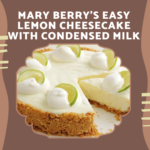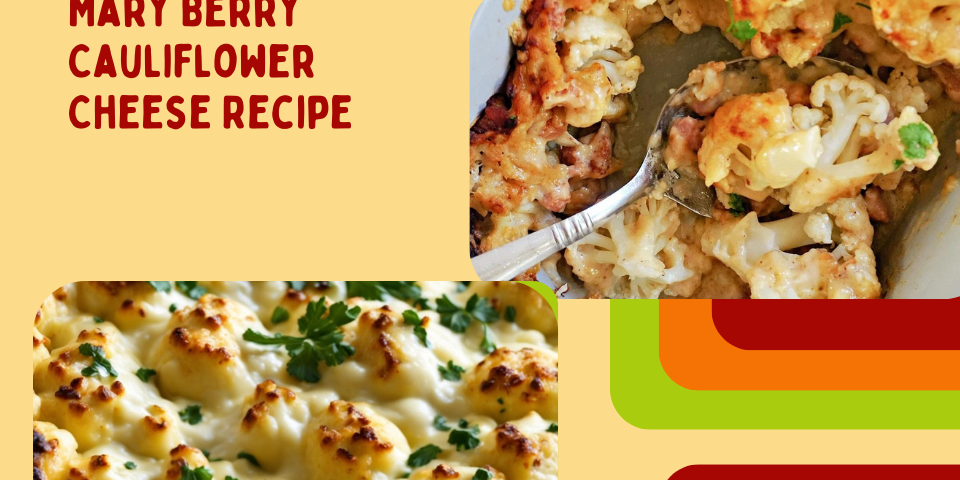
Mary Berry’s cauliflower soup
June 16, 2024
Mary Berry’s Easy Lemon Cheesecake With Condensed Milk
June 26, 2024Mary Berry Cauliflower Cheese Recipe
Mary Berry Cauliflower Cheese Recipe is a classic dish with tender cauliflower covered in a rich, creamy cheese sauce and topped with a golden, bubbly crust. Mary Berry Cauliflower Cheese Recipe can be a main dish or a tasty side and is easy to make. Mary Berry Cauliflower Cheese Recipe will likely become a family favorite.
What is Mary Berry Famous Cauliflower Cheese?
Mary Berry Cauliflower Cheese is a beloved classic from the renowned British cook. This dish transforms simple cauliflower into a creamy, cheesy delight that’s perfect as a main course or a side dish. With its rich sauce and golden, bubbly topping, it’s no wonder that this recipe has stood the test of time in many households. Mary Berry version adds a special touch with her unique blend of ingredients and straightforward cooking techniques.
Reasons to Love Mary Berry Cauliflower Cheese recipe.
There are many reasons to love Mary Berry Cauliflower Cheese.
- First, it’s very versatile and can be served as a comforting main dish or a tasty side.
- Second, it’s easy to make, so both beginners and experienced cooks can enjoy preparing it. Lastly, the creamy sauce and melted cheese create an irresistible flavor.
Essential Ingredients of Mary Berry Cauliflower Cheese Recipe
To make Mary Berry Ultimate Cauliflower Cheese, you will need the following ingredients:
- 1 large cauliflower, cut into florets
- 50g butter
- 50g all-purpose flour
- 600ml milk
- 100g mature cheddar cheese, grated
- 1 tsp Dijon mustard
- Salt and pepper to taste
- A pinch of nutmeg (optional)
- 25g grated Parmesan cheese
These ingredients come together to create a dish that’s rich, flavorful, and deeply satisfying.

Step-by-Step Guide to Making Mary Berry Cauliflower Cheese
Cooking Instructions
1. Get the Cauliflower Ready:
- Preheat your oven to 200°C (180°C fan) or 400°F.
- Cut the cauliflower into medium pieces.
- Boil a big pot of salted water, add the cauliflower, and cook for about 5 minutes until it’s just soft. Drain the water and set the cauliflower aside.
2. Make the Cheese Sauce:
- Melt the butter in a medium pot over medium heat.
- Add the flour and stir for 1-2 minutes to make a smooth paste.
- Slowly add the milk while stirring to avoid lumps. Keep cooking and stirring until the sauce gets thick and starts to bubble.
3. Add Cheese and Seasoning:
- Take the pot off the heat.
- Stir in the grated cheddar cheese until it melts and the sauce is smooth.
- Add Dijon mustard, a little nutmeg if you like, and season with salt and pepper.
4. Combine and Bake:
- Put the cooked cauliflower in a big baking dish.
- Pour the cheese sauce over the cauliflower, making sure it covers everything.
- Sprinkle-grated Parmesan cheese on top for extra cheesiness.
5. Bake Until Perfect:
- Bake in the oven for 20-25 minutes, or until the top is golden and bubbly.
- Let it cool a bit before serving.
Helpful Tips
- Consistency: If your sauce is too thick, add more milk to achieve the desired consistency.
- Extra Flavor: Add a pinch of nutmeg to the cheese sauce for an extra depth of flavor.
- Cheese Varieties: Experiment with different types of cheese, like Gruyère or Emmental, for a unique twist.
Serving Suggestions for Mary Berry Cauliflower Cheese
Mary Berry Cauliflower Cheese is incredibly versatile and pairs well with a variety of dishes. Serve it as a main course with a crisp green salad and some crusty bread for a light meal. Alternatively, it makes an excellent side dish for roasted meats, grilled chicken, or fish. It’s also a fantastic addition to a holiday meal spread, complementing turkey, ham, or lamb perfectly.
Perfect Pairings with Mary Berry Cauliflower Cheese
- Roast Dinners: Serve alongside roast beef, chicken, or lamb for a hearty and satisfying meal.
- Vegetarian Meals: Pair with a variety of roasted or steamed vegetables, such as carrots, peas, or Brussels sprouts.
- Salads: A fresh, crisp salad with a tangy vinaigrette balances the richness of the cauliflower cheese.
Nutritional Facts
Mary Berry Cauliflower Cheese is not only delicious but also provides some nutritional benefits. Here’s an estimate per serving:
- Calories: 350
- Protein: 15g
- Fat: 25g
- Carbohydrates: 15g
- Fiber: 4g
- Calcium: 300mg
While this dish is indulgent, it also provides a good amount of protein and calcium, thanks to the cheese and milk.
Storing Leftovers of Mary Berry Cauliflower Cheese
If you have leftovers, storing them properly ensures you can enjoy this dish later. Allow the cauliflower cheese to cool completely before transferring it to an airtight container. It can be stored in the refrigerator for up to 3 days.
Reheating Mary Berry Cauliflower Cheese
- Oven Method: Preheat your oven to 180°C (350°F). Put the cauliflower cheese in an ovenproof dish and cover it with foil. Bake for 15 to 20 minutes until it’s heated through. This method helps retain its texture.
- Microwave Method: Alternatively, you can reheat individual portions in the microwave. Heat each portion on medium power for two to three minutes.
Choose the method that suits you best for reheating your cauliflower cheese.
Tips for Storage and Reheating
Proper storage and reheating are crucial to maintaining the quality of your cauliflower cheese: To keep your cauliflower cheese fresh and tasty by following tips:
- Storage: Store in the refrigerator in an airtight container for up to three days.
- Reheating: For best results in preserving flavor and texture, reheat in the oven. If you prefer a quicker method, reheating in the microwave is an option, though the texture may be less creamy.
Mary Berry Ultimate Cauliflower Cheese Recipe is a comforting addition to any meal. With its creamy cheese sauce and tender cauliflower, it’s sure to become a favorite whether for a special occasion or a weekday dinner. Enjoy!
How do you make Mary Berry cheese sauce?
To make Mary Berry cheese sauce, follow these steps:
- Melt Butter: In a medium saucepan, melt 50g of butter over medium heat.
- Create a Roux: Add 50g of all-purpose flour to the melted butter and stir continuously for 1-2 minutes to form a smooth paste, known as a roux.
- Add Milk: Gradually whisk in 600ml of milk, ensuring there are no lumps. Continue to cook and stir until the sauce thickens and begins to bubble.
- Incorporate Cheese: Remove the saucepan from the heat and stir in 100g of grated mature cheddar cheese until melted and smooth.
- Season: Add 1 teaspoon of Dijon mustard, and season with salt and pepper to taste. For an extra touch of flavor, you can also add a pinch of nutmeg if desired.
This cheese sauce is rich, creamy, and perfect for coating cauliflower in the classic dish.
How to stop cauliflower cheese from going watery?
To prevent cauliflower cheese from becoming watery, consider these tips:
- Pre-cook Cauliflower Properly: Cook the cauliflower florets until just tender but still firm, usually around 5 minutes. Overcooking can make them release more water.
- Drain Thoroughly: After boiling, drain the cauliflower well and let it sit in the colander for a few minutes to ensure excess water is removed.
- Pat Dry: Use a clean kitchen towel to pat the cauliflower florets dry before adding them to the baking dish.
- Thicken the Sauce: Ensure your cheese sauce is thick enough before pouring it over the cauliflower. If the sauce is too thin, it can add to the watery consistency.
- Bake Without Cover: When baking the cauliflower cheese, leave it uncovered. This helps any excess moisture evaporate during baking.
What is cauliflower cheese sauce made of?
Cauliflower cheese sauce is typically made from the following ingredients:
- Butter: For the base of the roux.
- All-purpose Flour: Combined with butter to create the roux, which thickens the sauce.
- Milk: Added to the roux to create a creamy sauce.
- Cheese: Mature cheddar is commonly used for its strong flavor, but other cheeses like Parmesan can also be added.
- Seasonings: Dijon Mustard, Salt, Pepper and Nutmeg (optional). These seasonings create a rich, creamy sauce that goes perfectly with cauliflower.
This combination creates a rich, creamy sauce that pairs perfectly with cauliflower
Is it best to freeze cauliflower cheese cooked or uncooked?
It is generally best to freeze cauliflower cheese cooked. Here’s why:
- Consistency: Cooking the dish before freezing helps to ensure the sauce has the right consistency and the flavors are well combined.
- Convenience: A cooked dish is easier to reheat directly from the freezer, making it a convenient option for quick meals.
- Quality: Freezing cooked cauliflower cheese helps to maintain its texture better compared to freezing it uncooked. Raw cauliflower can become mushy when thawed and cooked.
To freeze cooked cauliflower cheese, let it cool completely. Then, put it in a freezer-safe container. You can freeze it for up to 3 months.
Whenever you want to eat it, keep it in the fridge overnight, so it will be defrost. Then, reheat it in the oven at 180°C (350°F) until it’s hot all the way through.
By following these tips, you can enjoy Mary Berry cauliflower cheese at its best, even after freezing and reheating.
Conclusion:
In conclusion, the Mary Berry Cauliflower Cheese Recipe is a comforting favorite with its creamy sauce and tender cauliflower. Store leftovers in the fridge for up to three days and reheat in the oven for the best texture. It’s versatile enough for any meal and loved for its simple preparation and rich flavor, making it a timeless classic that brings warmth and joy to every table.


Can I make it ahead of time?
Yes, you can prepare the cheese sauce and cauliflower separately, even up to one day ahead of time. When ready to serve, mix and bake after storing them in the refrigerator.
Can I freeze cauliflower cheese?
Yes, cauliflower cheese can be frozen. After letting it cool completely, then transfer to a freezer-safe container. Up to three months it can be frozen.. To reheat, thaw in the refrigerator overnight and follow the reheating instructions.
How can I make it gluten-free?
To prepare the roux, replace the all-purpose flour with cornstarch or a gluten-free flour blend. Ensure all other ingredients should be gluten-free.


